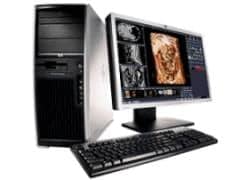Radiologic technologists and other medical imaging professionals in North Dakota will soon be able to take verbal orders from physicians and enter them into patients’ electronic health records, due to the successful passage of Senate Bill 2236.
North Dakota Gov. Jack Dalrymple recently signed the bill into law, a move that the bill’s supporters hope will inspire similar efforts across the country.

The NDSRT pursued licensure for technologists. Front Row: Donna Newman, Shirley Porter, Governor Dalrymple, Ann Bell-Pfeifer, Amy Hofmann. Back row: Chris Walski, Warren Freier, Rich Loftgren, Representative Todd Porter, Dr. Edward Fogarty, Janelle Anderson, Brenda Krogen.
Previously, state regulations prohibited radiologic technologists from taking verbal orders for imaging exams or procedures from physicians. Exact language from the code states that “telephone and verbal orders may be used, provided they are given only to qualified licensed personnel …” While radiologic technologists are qualified, they are only certified, not licensed, explained Ann Bell-Pfeifer, chair of the legislative committee of the North Dakota Society of Radiologic Technologists (NDSRT). “In an emergent situation, a technologist could not receive, relay or document a verbal order,” she continued. “The order had to be edited by a nurse or physician and be communicated to us in a written form before we could image a patient. We were unable to receive a verbal order and take action. That was a huge problem, and it caused a lot of angst.”
The rule’s technicality was brought to attention by North Dakota’s assistant attorney general after an insurer questioned an order that was taken by a CT technologist in the state. In this case, the CT tech—under the direction of a radiologist—changed an order from a no-contrast CT, to a study with contrast. “That was not deemed to be acceptable, even though receiving verbal orders is a common practice throughout the United States,” Bell-Pfeifer recalled. “It was a surprise to many.”
In immediate response to that ruling, Bell-Pfeifer and other members of the NDSRT requested, and were subsequently denied, a waiver provision that would permit them to take verbal orders temporarily. In the denial letter, the state outlined two avenues the group could take to resolve the issue: Change the language in the state’s administrative code, or become licensed. “For a multitude of reasons, it was very clear that licensure was the best option,” Bell-Pfeifer said. “One is that we wanted the ability to take verbal orders. Secondly, it would allow us to work within the full scope of the practice, for which we are educationally prepared and qualified.”
Licensure also impacts potential reimbursement for CMS EHR meaningful use core measure compliance (specifically stage 2 measures, measure 1 of 17), according to Bell-Pfeifer. “Failure to meet meaningful use core measures places health systems at risk for financial consequences,” she said. “It was important that we look at licensure impact as a whole.”
Effective December 31, 2015, the new law will set licensing standards and expand the responsibilities of the state’s radiographers, radiation therapists, radiologist assistants, nuclear medicine technologists, and sonographers. To oversee the licensure program, the state will create a nine-person State Board of Medical Imaging and Radiation Therapy Medical Examiners. Licensure fees, which will cover the cost of administering licenses, board service, and clerical duties, will be due every two years. Appointed by the governor and serving a four-year term, board members will represent a scope of modalities. Specifically, it will include a radiologist, medical physicist, a public member, a radiology educator, and representatives from general radiology, radiation therapy, nuclear medicine, sonography, and rural health.
“Enactment of S.B. 2236 is a huge step toward making sure patient care is provided as quickly and efficiently as possible,” Bell-Pfeifer added. “It will improve patient care by decreasing procedure and exam waiting times and allow medical imaging professionals to perform duties for which they are qualified and educationally prepared, including the ability to relay, receive and document verbal orders in the electronic medical record for medical imaging exams.”
Supporters of the bill included Republican State House Rep. Todd Porter, Republican State Sen. Judy Lee, the American Society of Radiologic Technologists, the North Dakota Society of Radiologic Technologists, the local American College of Radiology chapter, the state boards of nursing and medical examiners, Sanford, Essentia, and Altru health systems, and the Society of Diagnostic Medical Sonography (SDMS).
“As a professional in my field, I am thrilled to have had a small part in ensuring every patient undergoing an ultrasound in the state of North Dakota will have a qualified and competent sonographer,” said Chris Walski, SDMS member and Midwest Society of Diagnostic Ultrasound board member. “This law ensures a future where quality imaging will be the expectation for all patients in North Dakota.”
###




